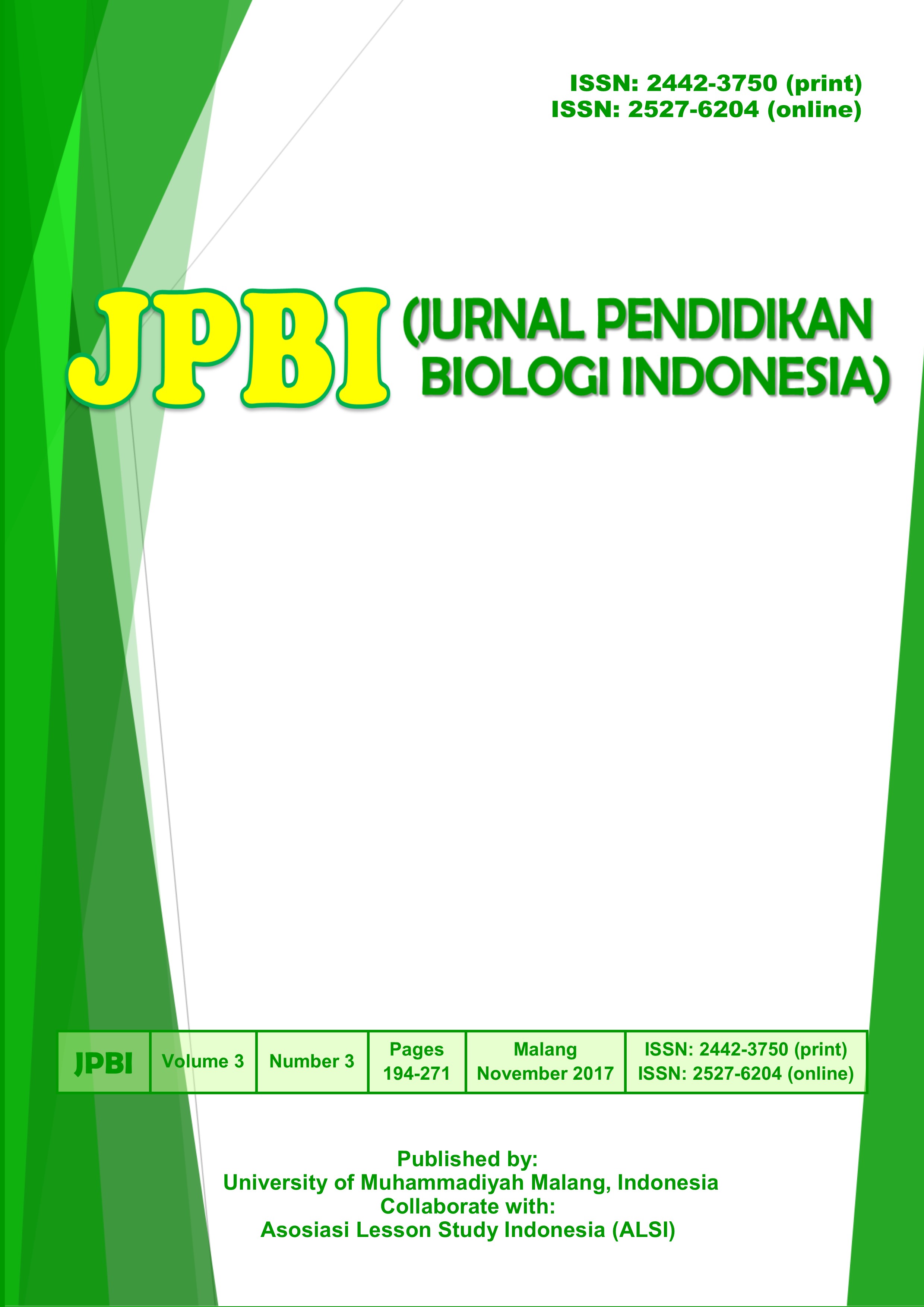The use of silica sand, zeolite and active charcoal to reduce BOD, COD, and TSS of laundry waste water as a biology learning resources
DOI:
https://doi.org/10.22219/jpbi.v3i3.4864Keywords:
Silica Sand, Zeolite, Activated charcoal, BOD, COD, TSSAbstract
The aquatic environment contaminated with detergent waste in high concentrations can endanger the lives human and biota in the water. This study aimed to determine the decrease of BOD, COD and TSS content of laundry liquid waste by using filter media of silica sand, zeolite, and activated charcoal. Filter medium 1a can reduce BOD level from 98.6 mg/L to 58.80 mg/L (40.36%), while medium 1b can decrease BOD level to 21.20 mg/L (78.48%). It showed that media 1a had not fulfilled the quality standard of BOD of waste water that is 50 mg/L, while media 1b had fulfilled the standard of quality. Filter media 1a can decrease COD level from 210 mg/L to 78.80 mg/L (62.47%), whereas medium 1b can decrease COD to 25.60 mg/L (87.80%). This showed that media 1a and media 1b had met the quality standard of COD of waste water that is 100 mg/L. Filter media 1a can decrease TSS level from 465 mg/L to 122.5 mg/L (73.65%), whereas medium 1b can decrease TSS level to 52.3 mg/L (88.75%). This showed that media 1a and media 1b had met the quality standard of TSS of waste water that is 150 mg/L.
Downloads
References
Abdullah, R., (2012). Learning Based Use Learning Resources. Didaktika, 12(2), 216-231.
AECT, (1977). The Definition of Educational Technology. Washington: Association for Educational Communication and Technology.
Ahmad and El-Desauky. (2008). Design Of a Modified Low Cost Treatmeant System For The Recycling and Reuse Of Laundry Waste Water. Journal Of Resources, Conservation and Recycling, 52(7), 973–978. Retrieved from www.elsevier.com/locate/resconrec.
Alaerts, santika, and Smestri, S. 1987. Metode Penelitian Air. Surabaya: Usaha Nasional.
Kasam, Y., Andik, and Sukma, T,. 2005. Decreasing Chemical Oxygen Demand in Liquid Waste Laboratory Using Coconut Shell Activated Coconut Activated Carbon Filter. Jurnal Logika. Vol. 2 (2), 3-17.
Retno R.S., Yuhanna W.L. (2016). The Learning Of Science Basic Concept By Using Scientifiq Inquiry To Improve Student’s Thinking, Working, And Scientific Attitude Abilities. Jurnal Pendidikan Biologi Indonesia, Vol 2(1), 1-9. Retrievedfrom.http://ejournal.umm.ac.id/index.php/jpbi/.
Rosita, D, Zaenab. S, Budiyanto M.A.K. (2016). The Analysis On The Chlorine Contents In Rice Circulation In Pasar Besar Of Malang As The Biological Learning Resource. Jurnal Pendidikan Biologi Indonesia. Vol 2(1), 88-93. Retrieved from http://ejournal.umm.ac.id/index.php/jpbi/.
Seo T. G ., T.S Lee, B.H. Moon, J.H.Lim. 2001. Ultrafiltration combined With Ozone For Domestic Laundry Wastewater Reclamation and Reuse. Water Suplai.
Siswandari A.M, Hindun.I, Sukarsono. (2016). Phytoremediation of Phosphate Content In Liquid Laundry Waste by Using Echinodorus paleafolius and Equisetum hyemale Used as Biology Learning Resourc. Jurnal Pendidikan Biologi Indonesia, Vol 2(3), 222-230. Retrieved from http://ejournal.umm.ac.id/index.php/jpbi/.
Sulpryan, Rischa. 2014. Pengaruh Treatment Air Limbah Laundry Dengan Menggunakan Eceng Gondok (Eichornia Crassipes). Skripsi Teknik Lingkungan Universitas Muhammadiyah Kendari.
Setyobudiarso, H, and Yuwono, E. 2014. Rancang Bangun Alat Penjernih Air Limbah Cair Laundry Dengan Menggunakan Media Penyaring Kombinasi Pasir-Arang Aktif. Jurnal Neutrino, Vol. 6(2) 84-90.
Sisyareswari, H; Oktiawan Wiharyanto; Rezagama Arya. 2014. Penurunan TSS, COD, dan Fosfat Pada Limbah Laundry Menggunakan Koagulan Tawas dan Media Zeolit. http://ejournal-s1. Undip. ac.id/index.php/tlingkungan/article/view/7133/6900. Diakses pada tangaal 20 juni 2017.
Downloads
Published
Issue
Section
License
Authors who publish with JPBI (Jurnal Pendidikan Biologi Indonesia) agree to the following terms:
- For all articles published in JPBI, copyright is retained by the authors. Authors give permission to the publisher to announce the work with conditions. When the manuscript is accepted for publication, the authors agree to automatic transfer of the publishing right to the publisher.
- Authors retain copyright and grant the journal right of first publication with the work simultaneously licensed under a Creative Commons Attribution-ShareAlike 4.0 International License that allows others to share the work with an acknowledgment of the work's authorship and initial publication in this journal.
- Authors are able to enter into separate, additional contractual arrangements for the non-exclusive distribution of the journal's published version of the work (e.g., post it to an institutional repository or publish it in a book), with an acknowledgment of its initial publication in this journal.
- Authors are permitted and encouraged to post their work online (e.g., in institutional repositories or on their website) prior to and during the submission process, as it can lead to productive exchanges, as well as earlier and greater citation of published work (See The Effect of Open Access).

This work is licensed under a Creative Commons Attribution-ShareAlike 4.0 International License.


















